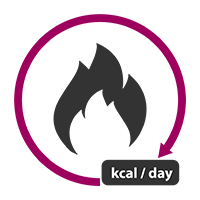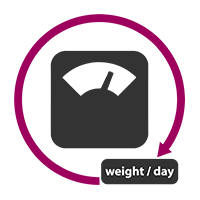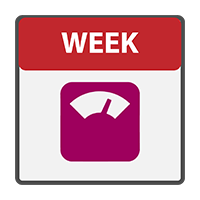Losing weight is not an easy task, we know this because it isn’t just you, countless others struggle with losing weight the right way. Keeping all the problems in mind, we have created this easy-going weight loss calculator which will help you on your journey. Just follow the instructions on the tool and you will have what you need in no time.
RESULTS
 ---
---
 ---
---
 ---
---
 ---
---
 ---
---
 ---
---
In this guide, we will also be discussing some additional information that will help you on this journey. Let’s start!
Understanding Weight Loss and Caloric Intake
To effectively shed pounds, it’s vital to grasp the intricate relationship between caloric intake and weight loss—a balance that hinges on consuming fewer calories than your body expends.
This understanding is key to crafting a sustainable strategy that caters to your unique metabolic needs and lifestyle factors.
Recommended Calorie Intake For Weight Loss
If you want to shed pounds, it’s all about burning more calories than you eat. Men should aim for 2000-3000 calories each day to lose weight. Women might go for around 1500 calories a day.
But this isn’t a one-size-fits-all deal! Your body needs enough food energy every day just to keep breathing and moving.
Losing weight safely means not going too fast – dropping more than 2 pounds per week is not good for your body. Eating fewer calories helps, but don’t cut down too much all at once or it can backfire.
Listen to your body and feed it right – less junk, more healthy foods – while staying active through things like jogging or resistance training. This way leads to lasting weight loss without harming your muscles or overall health.
The Importance Of Calorie Deficit
To shed pounds, burning more calories than what you eat each day is essential. This is called a calorie deficit. It’s like a magic rule for weight loss. Your body needs energy to work and move around.
When you eat less energy than your body uses, it has to find that energy from somewhere else, like the fat stored in your body.
Creating this calorie gap means your body starts using up stored fat for fuel. If you want to lose 1 pound of weight, aim for a total weekly deficit of about 3,500 calories; that’s roughly 500 fewer calories per day.
Eat nutritious foods and keep moving to achieve this balance without feeling hungry all the time or losing muscle instead of fat. Keep track of how much you’re eating and stay patient – over time, these small daily changes can lead to big results!
Factors Affecting Caloric Needs
Knowing how many calories you need to cut for weight loss is just the start. Different things can change how many calories your body needs each day. Here are some factors that affect your caloric needs:
- Your body size: Bigger people have more muscle and fat, so they burn more calories. This means they often need more calories than smaller people.
- Your age: As you get older, your metabolic rate usually goes down. This means you might need fewer calories.
- Being male or female: Men often burn more calories at rest than women because they usually have more muscle mass.
- How active you are: If you move a lot during the day or work out regularly, your body uses up more energy. So, very active people need more calories than those who aren’t as active.
- Muscle mass versus fat: Muscle burns more calories than fat even when you’re resting. Having more muscle will raise how many calories you burn each day.
- Pregnancy and breastfeeding: Women who are pregnant or breastfeeding need extra calories to support their baby’s growth and milk production.
- Overall health: Some health problems can speed up or slow down your metabolic rate, changing how many calories you should eat.
- Sleep patterns: Not getting enough sleep can affect hormones that control hunger and appetite. This might make your body use up fewer calories.
- Temperature and climate: When it’s very cold or hot, your body works hard to keep its normal temperature, which can change calorie burning.
Calculating Basal Metabolic Rate (BMR) and Total Daily Energy Expenditure (TDEE)
Before embarking on a weight loss journey, it’s crucial to understand your body’s energy needs. Calculating Basal Metabolic Rate (BMR) and Total Daily Energy Expenditure (TDEE) offers a scientific foundation for designing an effective calorie-controlled diet plan, taking into account factors unique to your physiological makeup and lifestyle.
Equations For Calculating BMR
Your body needs a certain number of calories just to stay alive. That’s where Basal Metabolic Rate (BMR) comes in. It’s the amount of energy you need at rest for your body to function properly. Here are some equations to calculate BMR:
- Mifflin – St Jeor Equation: This is a popular method used by health and fitness professionals. It takes into account your weight, height, age, and gender. To use this formula:
- For men: (10 x weight in kg) + (6.25 x height in cm) – (5 x age in years) + 5
- For women: (10 x weight in kg) + (6.25 x height in cm) – (5 x age in years) – 161
- Katch – McArdle Equation: This one is different because it looks at lean body mass instead of total body weight. It’s good for people who know their body fat percentage. To figure it out:
- First, calculate your lean body mass (total weight in kg – [body fat % x total weight]).
- Then use the formula: 370 + (21.6 x lean body mass in kg)
- Revised Harris – Benedict Equation: The original equation was updated to be more accurate and goes like this:
- For men: (13.397 x weight in kg) + (4.799 x height in cm) – (5.677 x age in years) + 88.362
- For women: (9.247 x weight in kg) + (3.098 x height in cm) – (4.330 x age in years) + 447.593
Determining TDEE Based On Activity Level
Knowing your Total Daily Energy Expenditure (TDEE) helps you understand how many calories you need. It changes based on how active you are every day.
- Learn about Basal Metabolic Rate (BMR). This is what your body needs to work at rest. It makes up about 70% of your daily calorie use.
- Look at the MET values for activities. MET stands for Metabolic Equivalent Task. It shows how much energy an activity uses.
- Think about what you do each day. Are you sitting a lot, or do you move around often?
- Put yourself in a category:
- Not Active: You don’t move much during the day, maybe just some walking.
- Lightly Active: You do light exercise or have a job that involves some walking.
- Moderately Active: You exercise most days of the week.
- Very Active: You work out hard or have a physical job.
- Use an equation to find your TDEE. Multiply your BMR by the number that matches your activity level:
- Not Active: BMR x 1.2
- Lightly Active: BMR x 1.375
- Moderately Active: BMR x 1.55
- Very Active: BMR x 1.725
- Keep track of what you eat and drink. Note the calories and compare them to your TDEE.
Strategies for Effective Weight Loss
To attain sustainable weight loss, adopting a strategic approach tailored to your unique metabolic needs and lifestyle is crucial. Implementing smart dietary tactics and incorporating consistent physical activity are foundational steps that set the stage for long-term success in achieving your weight management goals.
1. Zigzag Calorie Intake Schedule
A zigzag calorie intake schedule can trick your body and keep your metabolism active. You eat a different number of calories each day. Some days you might eat more, other days less, but the average should match what you need to lose weight.
This way helps stop your body from hitting a weight loss wall.
Eating like this needs planning but can make losing weight easier over time. Keep track of what you’re eating to stay on course for reaching your goal weight. Mix up high and low-calorie days throughout the week; it’s like playing a game with your food to win at losing pounds!
2. Intermittent Fasting And Regular Exercise
Intermittent fasting and regular exercise are powerful tools for losing weight. They work together to make your body burn fat and keep your muscles strong.
- Create a calorie deficit: Fasting limits when you eat, which often means you eat less. Less food equals fewer calories.
- Keep muscle mass: Exercise, like weightlifting, helps build and protect muscles even as you lose fat.
- Speed up metabolism: Moving more boosts your heart rate and burns calories faster.
- Boost insulin sensitivity: With better insulin control, your body stores less fat.
- Break down fat cells: When you fast, your body uses stored fat for energy after it runs out of blood sugar.
- Improve health overall: Regular movement and healthy eating habits can lower the risk of diseases like heart disease or diabetes.
- Maintain weight loss long-term: Combining diet with exercise helps keep the weight off once it’s lost.
Making Healthy Food Choices And Portion Control
Just as intermittent fasting and regular exercise play a role in weight loss, making smart food choices and watching portion sizes are key. You’ll want to pick foods that help you feel full longer and measure how much you eat.
- Eat more vegetables: They are low in calories but high in vitamins, minerals, and fiber.
- Choose whole grains over processed ones: Foods like brown rice or whole wheat bread keep you full longer.
- Pick lean proteins: Foods like chicken, fish, beans, or nuts can satisfy hunger without too much fat.
- Drink water instead of sugary drinks: Water has zero calories and can make you feel full before meals.
- Use smaller plates: This tricks your brain into thinking you’re eating more than you are.
- Avoid eating straight from the bag or box: Instead, put a single serving on a plate to avoid overeating.
- Learn to read nutrition labels: This helps understand what’s in your food so you can make better choices.
- Share meals when eating out: Restaurant portions often have more food than you need for one meal.
- Plan your meals ahead of time: Knowing what you’re going to eat helps prevent grabbing unhealthy options when hungry.
- Listen to your body: Eat when hungry but stop before you’re too full. It takes time for your brain to realize your stomach is full.
Sample Weight Loss Meal Plans
Discover tailored meal plans to kick-start your weight loss journey; each is designed with optimal caloric count and nutritious ingredients, ensuring you stay energized while shedding pounds—delve in for a healthier tomorrow.
1. 1200-Calorie Meal Plan
A 1200-calorie meal plan can help both men and women lose weight. Eating this way means you choose foods that give you the right nutrients but stay within your daily calorie goal. Think of fresh fruits, vegetables, lean proteins, and whole grains that fill you up but don’t have too many calories.
Drinks count too – choosing water or herbal tea over sodas can make a big difference.
This kind of meal plan keeps your energy intake low enough to lose fat but is still high enough to keep you feeling full and happy after meals. You’ll eat fewer calories without missing out on important vitamins and minerals that keep your body running well.
Following a plan like this could be just what someone needs to get healthier eating habits going strong!
2. 1500-Calorie Meal Plan
Moving up from a 1200-calorie plan, the 1500-calorie meal plan gives you more energy and makes sure all your nutrient needs are met. Women looking to lose weight can benefit greatly from this amount.
This plan includes three meals and two snacks, keeping you full and satisfied while helping your body burn fat. Each meal is carefully chosen to give you the right mix of protein, carbs, and fats.
For example, breakfast could be oats with berries and a slice of whole-grain toast. Lunch might be a turkey sandwich with lettuce on whole-grain bread plus an apple. Dinner can be grilled chicken with steamed vegetables and quinoa.
Snacks could include Greek yogurt or almonds. With this kind of eating pattern, it’s easier to stick to your goals because you’re not hungry all the time. Plus, having some extra calories means more food choices so you can enjoy different flavors every day!
3. 2000-Calorie Meal Plan
A 2000-calorie meal plan fits right in the middle for those wanting to cut back on calories without being too strict. It’s a good choice if you’re a woman aiming for 1500 calories but need something more filling, or if you’re a man who finds that 3000 calories is too much.
This plan helps manage hunger and maintain energy levels while working towards weight loss goals. Packed with nutrient-rich foods, it balances your body’s needs within calorie limits.
Eating the right mix of proteins, fats, and carbs keeps your metabolism humming along. Try including low-calorie foods like veggies and fruits in each meal to help feel full without going overboard on calories.
And don’t forget about staying active; mixing this meal plan with exercise boosts your chance for success. Now let’s look at some sample workouts that can complement this meal plan by burning extra calories.
FAQs
Question: How Does The Calorie Calculator Help With Weight Loss?
The calorie calculator tells you how many calories to eat so your body can start using fat for energy, which helps you lose weight.
Question: Can This Tool Give Advice On What Types Of Food To Eat?
Yes, it can offer suggestions on healthy diets, like low-carb or low-fat foods, and make sure you get the right mix of nutrients.
Question: Do I Need To Know My Body Composition For The Calculator To Work Well?
It’s best if you do because knowing things like muscle and fat in your body gives more accurate numbers for losing or maintaining your weight.
Question: Will A Dietitian Use Metrics From These Calculators?
Dietitians might use information like your basal metabolic rate (how many calories your body needs at rest) from the calculator along with other details about food and nutrition when they help plan meals.
Question: Is Exercise Part Of Using A Weight-Loss Calculator?
Yes! The tool often asks about activities such as biking since moving more can mean burning more calories or needing different nutrient recommendations.
Conclusion
To lead a healthier lifestyle, we need to eat well and have the right kind of diet. We have created the Weight Loss Calculator only for this purpose. With our dedicated tool, you will be able to lose weight in no time, just be sure to follow our guidelines and other strategies.
Your body needs energy every day, and knowing what it uses helps you make smart food choices. Do you want to try changing up your daily calories? Think about using a plan like zigzag calorie intake to beat standstills in losing weight. Ensure healthy eating and exercise today for a happier, healthier life!
If you have any questions or need specific guidance then let us know in the comments!
